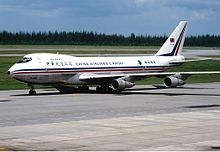You can help expand this article with text translated from the corresponding article in Chinese. (October 2012) Click [show] for important translation instructions.
|
 B-198, the aircraft involved, at Changi Airport a year before the incident. | |
| Hijacking | |
|---|---|
| Date | May 3, 1986 |
| Summary | Hijacking |
| Site | Guangzhou Baiyun Airport, Guangdong, China |
| Aircraft | |
| Aircraft type | Boeing 747-2R7F/SCD |
| Operator | China Airlines |
| Registration | B-198 |
| Flight origin | Singapore Changi Airport, Singapore |
| 1st stopover | Don Mueang Airport, Bangkok, Thailand |
| 2nd stopover | Kai Tak Airport, British Hong Kong |
| Destination | Chiang Kai-shek Airport, Taoyuan, Taiwan |
| Occupants | 3 |
| Passengers | 0 |
| Crew | 3 |
| Fatalities | 0 |
| Survivors | 3 |
China Airlines Flight 334 was a Boeing 747-2R7F/SCD freighter aircraft that was hijacked by pilot Wang Hsi-chueh (Chinese: 王錫爵), a former military U-2 pilot, on May 3, 1986, while en route to Don Mueang, Thailand. Wang had left family members behind in China when he left for Taiwan in 1949 and had met some of them in Hong Kong in 1984. He decided to defect in order to reunite with his family in China.[1] Wang managed to subdue the two other crew members and changed course to land the 747 in Guangzhou, where he defected to the People's Republic of China. The incident forced the Chiang Ching-kuo government in Taiwan to reverse its Three Noes policy in regard to contacting the communist government in mainland China, and Chiang dispatched several delegates to Hong Kong to negotiate with mainland officials for the return of the aircraft and crew. The incident was credited as a catalyst in renewing cross-strait relations between mainland China and Taiwan.[2][3]
- ^ "The U-2 pilot who defected to China has passed away". Military Aviation News. July 14, 2021. Retrieved November 13, 2023.
- ^ "Pilot lands in China, asks to defect" Chicago Tribune. May 4, 1986.
- ^ Han Cheung (May 23, 2021). "Taiwan in Time: When the hostage was the hijacker". Taipei Times. Retrieved May 23, 2021.